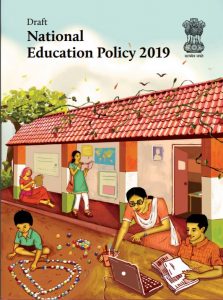 By Prof. S.N. Misra* in Bhubaneswar, February 13. 2023: The Education Policy of India stands on the tripod of Universal access, Absence of gender discrimination & Quality. Post RTE Act 2009, the access dimension and equity has been largely achieved while learning outcome remains extremely unsatisfactory in our public schools. NEP 2020 recognizes that education is fundamental to achieving full human potentialand implores the govt. to provide quality education to all its students.
By Prof. S.N. Misra* in Bhubaneswar, February 13. 2023: The Education Policy of India stands on the tripod of Universal access, Absence of gender discrimination & Quality. Post RTE Act 2009, the access dimension and equity has been largely achieved while learning outcome remains extremely unsatisfactory in our public schools. NEP 2020 recognizes that education is fundamental to achieving full human potentialand implores the govt. to provide quality education to all its students.
Five years earlier SDG goal 4 had also flagged that all countries must “ensure inclusive and equitable quality education and promote life long learning opportunity for all”. It is against this backdrop, ASER 2022 survey assumes huge salience. More so, since its last field survey was conducted in 2018. The report takes into account 616 districts, 1.9 lakh villages, and around 7 lakh children. Some of the interesting findings have been that in terms of enrolment, there has been hardly any reduction.
In terms of attendance in schools, there are interesting inter-regional differences, with south and western havingan attendance of 80%, Central and North-centralstates 50-60%, and the eastern states 60-70%. There has been a dramatic drop in the percentage of children going to private schools. As against 30.9% in 2018, it has come down to 25% in 2022 clearly showing that due to the economic distress during the pandemic, many parents from low-income categories have shifted their children from private schools to government schools.
 Tuition had a field day during the pandemic, with the percentage of children going for tuition increasing from 26.4% in 2018 to 30.5% in 2022. There is a sharp variation between states in this regard. For instance, in states like Bihar, the % of students going for tuition has gone up from 62% in 2018 to 72% now, while it was as low as 10% in Himachal Pradesh.
Tuition had a field day during the pandemic, with the percentage of children going for tuition increasing from 26.4% in 2018 to 30.5% in 2022. There is a sharp variation between states in this regard. For instance, in states like Bihar, the % of students going for tuition has gone up from 62% in 2018 to 72% now, while it was as low as 10% in Himachal Pradesh.
Despite the supply of textbooks to the govt schools and the complete involvement of parents to help out children, the learning outcomes show a distressing trend. In terms of reading by a grade III student of a grade 1 book, the % has dropped from 27.2% to around 20.5%. In terms of a grade III child’s ability to subtract, the % has gone down from 28.1% in 2018 to 25.9% in 2022.
This clearly shows the sharp dip in the learning outcomes which were already at a very low level. In terms of facilities, the percentage of usable toilets has gone up marginally from 74% to 76% in 2022. 56% of the schools still don’t have a proper library and 92% don’t have access to a computer. Except for Kerala, where 20% of school computer availability, in a state like Odisha, it is as low as 5%.
 The NEP 2020 suggested that there is a need to integrate preschool education in the Anganwadis with school education in public schools, with ages 3 to 8 being considered as an integrated foundational stage for every child. It noted with concern that the 27 lakh Anganwadi workers working in 14 lakh centers have to render 6 different services to the children including nutrition, basic healthcare, and preschool education to children.
The NEP 2020 suggested that there is a need to integrate preschool education in the Anganwadis with school education in public schools, with ages 3 to 8 being considered as an integrated foundational stage for every child. It noted with concern that the 27 lakh Anganwadi workers working in 14 lakh centers have to render 6 different services to the children including nutrition, basic healthcare, and preschool education to children.
It notes with dismay that only 40% of these children are actually enrolled in AWC (Anganwadi Centers) for Early Childhood education. The quality of learning leaves a lot to be desired. It, therefore, suggested that there should be a significant improvement in the infrastructure facilities of AWCs, play equipment provided, and Anganwadi workers/teachers properly trained. The Anganwadis should be fully integrated into the school campus as against only 44% which are integrated with the school.
To the credit of the finance minister, it must be said that she had announced in the last budget that the 2 lakh AWCs would be upgraded @ 40000 per year. However, the allocational trends clearly reveal that these pious promises have not been followed up with suitable allocation. From the Kothari Committee recommendations in 1968 that 6% of the GDP should be allocated to education, and Prof Amartya Sen’s fervent call to earmark significant allocation for capability development, the current spending by the center and the states would show a disturbing fixation at around 3.5% of GDP.
 On average, only 10% of total expenditure is earmarked by most states for education. The states of Kerala and Delhi are outliers in this regard and spend close to 17-18% on improving school infrastructure and the quality of training of teachers. Prof Lekha Chakravarty empirically shows that allocation to education has a better positive correlation with HDI than focusing only on GDP growth.
On average, only 10% of total expenditure is earmarked by most states for education. The states of Kerala and Delhi are outliers in this regard and spend close to 17-18% on improving school infrastructure and the quality of training of teachers. Prof Lekha Chakravarty empirically shows that allocation to education has a better positive correlation with HDI than focusing only on GDP growth.
SDG goal 4 sets a very ambitious target of 12 years of free publicly funded inclusive and equitable primary and secondary education. Universal literacy and numeracy and equal access to quality pre-primary education have been the major targets of SDG goal 4. Quite clearly, the RTE Act and our constitutional dispensation in treating primary and preprimaryeducation differently vary sharply from the SDG goal. Unless informal learning seamlessly segues into formal learning and the child by the age of 8 has basic foundational literacy and numeracy skills, the concept of demographic dividend is likely to degenerate into a demographic disaster.
Many discerning observers believe that there are deep structural issues in our school education. The curriculum is often ambitious and the teachers are ill-equipped to ensure that most children are in sync with the curriculum and the learning expectations. Given the fact that nearly 75% of children are getting left behind in our govt schools, there is a necessity to introduce catch-up interventions in our public schools on an urgent basis.
The report brings out that compared to the govt schools, the learning outcomes in private schools is far better. Unless we fix the infrastructural and teaching deficits in the govt schools the reverse trend in favor of private schools is not unlikely. The FM has made a token increase in the school budget from 60,000 crores to 68000 crores. Rosenstein Rodan (1943) suggested that for taking a country out of the morass of illiteracy and poor industrialization the govt must give a big push rather than indulging in incrementalism and tokenism.
The ASER 2022 report is a timely warning to the govt to allocate enough for school education, rev up its quality to achieve a universal foundation in literacy & numeracy & pave the path for a just and equitable India.
• Professor Emeritus


Leave a Reply
Be the First to Comment!